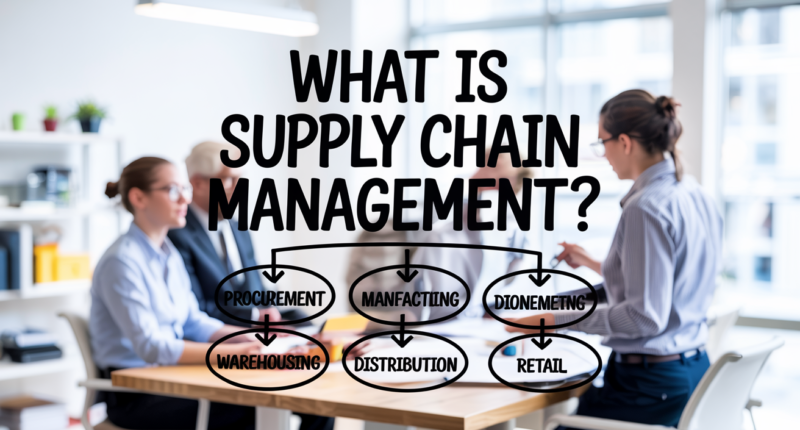Supply chain management (SCM) is the discipline of overseeing how a product or service moves from raw materials to the customer. As Investopedia explains, SCM monitors and optimizes production and distribution to enhance efficiency and value. Because a supply chain involves many organizations, effective management aims to reduce waste, maximize customer satisfaction and secure a competitive edge. Likewise, the Corporate Finance Institute notes that a supply chain is the entire system of producing and delivering a product or service, from sourcing raw materials to final delivery. Therefore, understanding SCM helps business professionals see the bigger picture and make better strategic decisions.
Understanding the Supply Chain
To begin with, a supply chain stretches far beyond a single company; it is an ecosystem that includes suppliers, manufacturers, distributors, retailers and customers. The Corporate Finance Institute describes the generic supply chain as starting with raw material extraction, moving through logistics providers and manufacturers and ending at retailers and consumers. When a customer buys a product, that demand flows back up the chain and triggers more production. In an e‑commerce supply chain, additional players like checkout systems, payment processors and third‑party logistics providers manage online orders, warehousing and last‑mile delivery. Hence, mapping the chain helps companies define their market and determine where they want to operate.
Key Components of Supply Chain Management
Planning

First, SCM begins with careful planning and forecasting. Companies must predict what resources and raw materials will be needed, determine production capacity and align supply with anticipated demand. DeVry University notes that this planning is often aided by analytical tools, such as material requirement planning software, to determine resource availability and cost. By analyzing historical sales data and market trends, businesses can minimize shortages or excess inventory.
Sourcing
Next, sourcing involves building strong relationships with vendors to ensure the right materials arrive on time and at reasonable cost. Companies evaluate suppliers based on quality, price and flexibility. According to DeVry University, careful sourcing is crucial for maintaining production timelines and profit margins. Therefore, selecting trustworthy suppliers and diversifying them for resilience is essential.
Manufacturing
After securing materials, the manufacturing phase transforms components into finished products. This stage includes assembly, testing, inspection and packaging. Managers must monitor waste and adjust operations if consumption of raw materials exceeds plans. Similarly, DeVry notes that production may change based on customer needs or efficiency improvements, making flexibility important.
Delivery
Subsequently, products are delivered to customers through robust logistics networks. Effective SCM requires backup or diverse distribution methods to handle disruptions like bad weather. DeVry emphasizes that meeting customer expectations means fulfilling orders promptly and accurately while ensuring product quality. Consequently, companies often partner with third‑party logistics providers or invest in technology to track shipments.
Returns
Finally, the process concludes with managing returns or reverse logistics. Handling defective or unwanted products requires systems for refunds and feedback. DeVry points out that customer support during this stage can improve efficiencies and maintain positive relationships. Thus, learning from returns helps prevent future problems.
Why Supply Chain Management Matters
Because supply chains are complex, proper management brings significant benefits. ShipBob explains that SCM helps prevent disruptions, saves money by eliminating inefficiencies, shortens lead times and ensures enough inventory to meet demand. Moreover, a coordinated supply chain creates a seamless customer experience by delivering orders quickly and accurately. DeVry adds that effective SCM reduces costs, maximizes production efficiencies and minimizes waste. Additional benefits include better collaboration with suppliers, improved quality control, optimized shipping, reduced inventory and overhead costs and stronger cash flowdevry.edu. Therefore, investing in SCM can enhance profitability and competitiveness.
Real‑World Examples of SCM
To see SCM in action, consider Walgreens Boots Alliance. Investopedia reports that Walgreens used big data from its 9,000 stores and 20,000 suppliers to improve forecasting and manage sales and inventory. The company also incorporated supply chain management into its environmental, social and governance (ESG) initiatives by surveying suppliers about emissions reduction targets and materials used. This holistic approach illustrates how SCM can support sustainability while boosting efficiency.
Another example comes from the ShipBob article. For an online business selling scented candles, SCM includes determining which scents to produce, ordering wax and wicks, arranging transportation of raw materials, auditing inventory and partnering with a third‑party logistics provider. Because each stage must be coordinated, supply chain managers continuously monitor processes to avoid bottlenecks and maintain customer satisfactionshipbob.com. These examples show that both large corporations and small e‑commerce brands rely on SCM to stay competitive.
Ultimately, supply chain management is more than logistics; it is a comprehensive strategy that aligns planning, sourcing, manufacturing, delivery and returns. By mapping the entire supply chain, businesses can identify opportunities to improve efficiency and respond quickly to market changescorporatefinanceinstitute.com. Effective SCM reduces costs, improves product quality and enhances customer experience. With modern data analytics and a focus on collaboration and sustainability, supply chain management will continue to be a critical driver of business success in 2025 and beyond.









